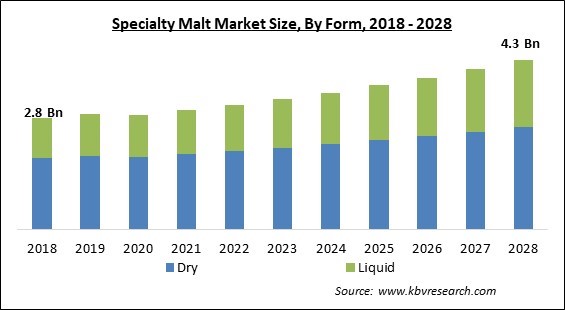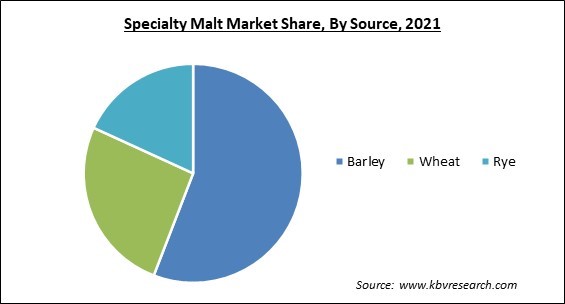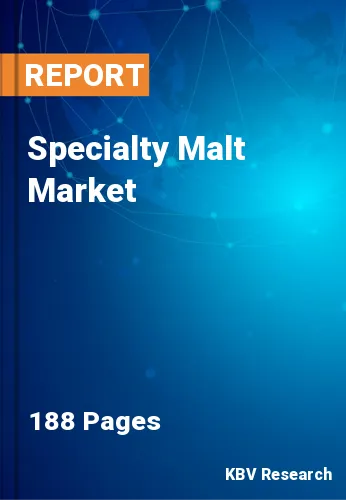The Global Specialty Malt Market size is expected to reach $4.3 billion by 2028, rising at a market growth of 5.3% CAGR during the forecast period.
Specialty malts are characterized by having a higher proportion of lighter malts and a lower proportion of flavored or colored malts. To obtain the required sweetness, taste, color, and effect, specialty malts are steeped and kilned in a special way. Conventionally, specialty malt is made from wheat, barley, or rye. Barley is the most popular grain among these sources for malting, which is utilized for a variety of purposes. All malts besides normal malt are considered specialty malts.

They are mainly manufactured by controlling the process of drying. Specialty malts offer unique qualities that boost craft beer's attributes such as a longer product shelf life, improved taste, an increase in foam and foam persistence, and ultimately brewing performance. A dried, germinated cereal grain is what is known as malt. By soaking grains in water to start the germination process, grains are then dried with hot air to stop further germination.
Although making whiskey or beer is the primary use of the malt, it can also be used to manufacture vinegar or malt extract. Many different grains, including barley, wheat, rye, and sorghum, are malted. Grains that have been malted provide the enzymes needed to convert the starches in the grain into sugars. Other enzymes have also been developed, such as protease, which primarily works in the breakdown of proteins to produce a by-product that the yeast can use.
The pandemic had affected a number of industries, including the food and beverage sector, in a variety of ways. On the market for specialty malts, negative repercussions were observed. The widespread lockdowns had a drastic impact on supply and demand. Unlike other industries, a shift in consumer behaviour has resulted in higher demand for a number of different food and beverage categories as well as altered product preferences. Manufacturers are also deciding how to best deal with potential supply chain disruptions and capacity issues that can prohibit them from meeting changing client demands.
Malt extract is gaining popularity once again as a naturally functioning substance with numerous potent intrinsic health advantages. One of the reasons why sportsmen are increasingly turning to beverages made from malt extract is to refuel and recuperate. Additionally, malt extract contains hordenine, a naturally occurring chemical derived from plants that have been shown in tests to uplift mood. Hordenine has been demonstrated to stimulate the brain's reward center, the dopamine D2 receptor, which results in this "feel-good" effect.
Many non-alcoholic beers have been promoted as a healthy alternative for beer drinkers who like the flavour but don't want the side effects of alcohol. Each unit of alcohol has 56 calories. These empty calories have no nutritional value. When a pint of beer is substituted for a non-alcoholic beverage, it would save up to 145 calories, which is almost equal to six teaspoons of sugar. This factor alone is responsible for high sales of non-alcoholic beverages in developed nations.
High changes in manufacturing costs have the potential to have a significant impact on the growth of the market for specialty malts. Energy, water, distribution, as well as other external considerations like material upkeep and labour, all affect how much malt costs to produce. Since suitable ventilation and drying mechanisms are needed both before and during the malting process, energy consumption greatly raises the cost.

Based on form, the specialty malt market is bifurcated into liquid specialty malts and dry specialty malts. The dry specialty malt segment procured the maximum revenue share in the specialty malt market in 2021. Less dry specialty malt extract can be used to reach the desired gravity since it has a higher extract yield that is fermentable. Dry specialty malt often has fewer storage concerns and longer shelf life. Since they are dry, it becomes significantly simpler to precisely measure. It can be weighed in fractions of an ounce using a digital scale.
On the basis of source, the specialty malt market is divided into rye, barley, and wheat. The wheat segment procured a substantial revenue share in the specialty malt market in 2021. With little effect on colour, wheat malt is an additional grain that adds body, head stability, diastatic power, and a bready wheat flavour. A small amount can be used to flavour ales and lagers, or a bigger quantity might form the foundation of a German Weizen. While it lacks the bitter, astringent, dry, or aftertaste of Black Malt, it contributes the same colour qualities. It has the cleanest finish of any malt and is the smoothest source of black colour.
Based on application, the specialty malt market is segmented into non-Alcoholic Malt beverages, bakery & confectionary, alcoholic beverages, dairy & frozen products, and others. The alcoholic beverages segment dominated the specialty malt market with the largest revenue share in 2021. One of the most important factors for this is growth is the popularity for beer. For the creation of beer, malt is a necessary ingredient. Brewing is the process of making beer by steeping malt in hot water and allowing the resulting liquid to ferment with yeast. Specialty malt brewing can be done in a commercial brewery, at home, or using a number of conventional techniques employed by industrial brewers.
| Report Attribute | Details |
|---|---|
| Market size value in 2021 | USD 3 Billion |
| Market size forecast in 2028 | USD 4.3 Billion |
| Base Year | 2021 |
| Historical Period | 2018 to 2020 |
| Forecast Period | 2022 to 2028 |
| Revenue Growth Rate | CAGR of 5.3% from 2022 to 2028 |
| Number of Pages | 188 |
| Number of Tables | 360 |
| Report coverage | Market Trends, Revenue Estimation and Forecast, Segmentation Analysis, Regional and Country Breakdown, Companies Strategic Developments, Company Profiling |
| Segments covered | Form, Source, Application, Region |
| Country scope | US, Canada, Mexico, Germany, UK, France, Russia, Spain, Italy, China, Japan, India, South Korea, Singapore, Malaysia, Brazil, Argentina, UAE, Egypt, South Africa, Nigeria |
| Growth Drivers |
|
| Restraints |
|
On the basis of region, the specialty malt market is analyzed across North America, Europe, Asia Pacific, and LAMEA. The North American region procured a substantial revenue share in the specialty malt market in 2021. This can be ascribed to the increased consumption of malt-based goods in these areas, such as malted milk and beer. The segment has further expanded as a result of the rising demand for specialty malts in a variety of brewing applications and the increasing use of specialty malts in numerous food products.
Free Valuable Insights: Global Specialty Malt Market size to reach USD 4.3 Billion by 2028
The market research report covers the analysis of key stake holders of the market. Key companies profiled in the report include GrainCorp Limited, The Soufflet Group, Muntons plc, Malteurop, Axereal, Briess Malt & Ingredients Co., Crisp Malt, Viking Malt Oy (Polttimo Oy), Rahr Corporation and Simpsons Malt Limited.
By Form
By Source
By Application
By Geography
The Specialty Malt Market size is projected to reach USD 4.3 billion by 2028.
Boosts athletic recovery as it enhances mood and promotes good heart health are driving the market in coming years, however, High degree of production cost volatility and climatic restrains the growth of the market.
GrainCorp Limited, The Soufflet Group, Muntons plc, Malteurop, Axereal, Briess Malt & Ingredients Co., Crisp Malt, Viking Malt Oy (Polttimo Oy), Rahr Corporation and Simpsons Malt Limited.
The expected CAGR of the Specialty Malt Market is 5.3% from 2022 to 2028.
The Barley market is leading the Global Specialty Malt Market by Source in 2021; thereby, achieving a market value of $2.3 billion by 2028.
The Europe market is showcasing a high growth rate in the Global Specialty Malt Market by Region in 2021; thereby, achieving a market value of $1,598.4 million by 2028.
Our team of dedicated experts can provide you with attractive expansion opportunities for your business.

